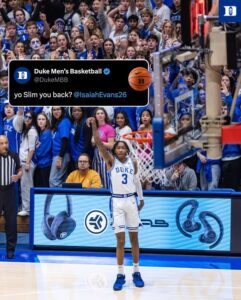
In the ever-evolving landscape of college football, the significance of the transfer portal has grown exponentially. As recruitment practices shift and the market for college athletes expands, the Transfer Portal has become a critical tool for teams looking to fill gaps, address weaknesses, or bolster their roster with immediate-impact players. LSU Football’s transfer class being ranked No. 1 by ESPN in recent rankings marks a turning point for the program and signals the powerful influence that strategic transfers can have on the future of college football. This feat speaks volumes about LSU’s recruiting acumen, its ability to attract top-tier talent, and its vision for the future under head coach Brian Kelly.
The Impact of the Transfer Portal on College Football
To understand why LSU’s transfer class stands out, we first need to explore the broader significance of the transfer portal. The transfer portal, which became a permanent fixture in college football in 2018, allows athletes to explore opportunities at other programs while maintaining eligibility. This system has drastically altered the way college programs assemble their rosters. Prior to the portal, student-athletes who transferred had to sit out a year before playing, a rule that often made transfers less appealing. However, with the portal’s new rules, players can now transfer and play immediately, which has revolutionized how teams manage their rosters.
For programs like LSU, the transfer portal presents both a challenge and an opportunity. On one hand, it can be difficult to keep pace with the shifting rosters of rival teams that might poach talent or secure high-profile transfers. On the other hand, the transfer portal is a tool that allows teams to immediately fill holes in their lineup—whether they need a quarterback, running back, wide receiver, or defensive playmaker. The portal provides a quicker path to success than traditional recruiting, and LSU’s No. 1-ranked transfer class highlights how successful programs are adapting to the changing dynamics of college football.
LSU’s Transfer Class Under Brian Kelly
Brian Kelly’s tenure at LSU has brought an air of optimism and transformation to Baton Rouge. After a successful stint at Notre Dame, Kelly took over as the head coach of LSU, inheriting a program with rich history and high expectations. However, Kelly also faced a series of challenges, most notably rebuilding the roster and getting the team back to championship contention. One of the most impressive elements of Kelly’s approach has been his ability to leverage the transfer portal to quickly elevate the team’s talent pool.
LSU’s football program has always been a talent-rich environment, but like many programs, it experienced some attrition and turnover in recent years. Kelly recognized that the quickest way to rebuild a program in today’s college football environment was not just through traditional recruiting, but through strategic transfers. In his first offseason as LSU’s head coach, Kelly made a splash by securing commitments from several high-profile transfers who immediately upgraded the team’s depth and skill level.
The 2023 transfer class, which ESPN ranked as the No. 1 class in the nation, is a testament to Kelly’s vision and recruiting savvy. This class is a combination of experienced, high-caliber players who can step in and make an immediate impact, along with younger prospects who have tremendous upside. By filling key positions with players who had already demonstrated their ability at the college level, Kelly significantly accelerated LSU’s return to national prominence.
Key Transfers in LSU’s No. 1-Ranked Class
Let’s take a closer look at some of the standout transfers who helped LSU achieve this top-ranking. These players not only bolstered LSU’s roster but also represented key positions of need that the Tigers were looking to improve.
-
Jaden Daniels (Quarterback, Arizona State)
One of the most important additions to LSU’s transfer class was quarterback Jaden Daniels, who transferred from Arizona State. A dual-threat quarterback with exceptional mobility, Daniels provided a much-needed upgrade at the quarterback position. In his time at Arizona State, Daniels displayed the ability to make plays with both his arm and his legs, showcasing versatility and leadership. His ability to stretch the field and make plays outside of the pocket was a crucial asset for LSU’s offense.Daniels’ arrival at LSU gave Kelly a quarterback with experience and the potential to be the face of the program. The move instantly solidified LSU’s quarterback room, and Daniels became a key figure in LSU’s offensive success in the 2023 season.
-
Mason Taylor (Tight End, Texas)
Tight end Mason Taylor’s transfer from Texas added a crucial dimension to LSU’s passing game. The tight end position had been a somewhat underutilized role in the past for LSU, but Taylor brought the size, athleticism, and skill to become a dynamic threat in both the passing and blocking game. With tight ends becoming more integral in modern offenses, particularly in the SEC, Taylor’s addition provided LSU’s offense with more flexibility and mismatches against opposing defenses. -
Makenzie Milton (Wide Receiver, Oklahoma)
Another key addition was wide receiver Makenzie Milton, a transfer from Oklahoma. Known for his excellent route-running and ability to create separation, Milton helped bolster LSU’s receiving corps. The Tigers were looking to replace some key contributors in their passing game, and Milton’s ability to stretch the field and make big plays gave LSU an instant deep threat. His presence also provided invaluable leadership to a young receiving group. -
Harold Perkins Jr. (Linebacker, Texas A&M)
On the defensive side of the ball, Harold Perkins Jr. was a significant get for LSU’s transfer class. A top-tier linebacker from Texas A&M, Perkins’ ability to impact the game from the linebacker position was immediately apparent. A versatile player who can rush the passer and drop into coverage, Perkins added another dimension to LSU’s defense and gave them a linebacker capable of disrupting opposing offenses. -
Greg Brooks (Defensive Back, Arkansas)
Adding a veteran defensive back like Greg Brooks from Arkansas was another key move for LSU. Brooks brought stability and experience to LSU’s secondary, which was crucial given the team’s need to improve its pass defense. A skilled and physical cornerback, Brooks immediately contributed to the depth and versatility of LSU’s defensive backfield, giving the Tigers a reliable playmaker who could match up with some of the best receivers in the SEC.
The Long-Term Benefits of LSU’s Transfer Class
While LSU’s No. 1-ranked transfer class will have an immediate impact on the 2023 season, the long-term effects are also worth considering. In the short term, these players have elevated LSU’s talent level and given them the pieces they need to compete for an SEC title and potentially a national championship. However, the success of this transfer class will also influence future recruiting efforts.
-
Increased National Appeal
By landing the No. 1-ranked transfer class, LSU has shown that it can attract some of the best available talent from around the country. Players who may not have previously considered LSU are now more likely to take notice. The success of this class sends a message that LSU is not only a traditional powerhouse but also a program capable of modernizing its recruiting strategies and adapting to new realities in college football. -
A Blueprint for Future Success
The 2023 transfer class serves as a model for future recruiting classes. By focusing on key positions of need and targeting players who can make an immediate impact, LSU has demonstrated that transfers are not just a stopgap measure but a legitimate path to building a championship-caliber team. As more players enter the transfer portal in the coming years, LSU will likely continue to be a top destination for transfers, keeping the program competitive on a national scale. -
Sustaining Success
The transfer portal gives LSU a unique opportunity to sustain success even when it faces challenges in traditional recruiting cycles. Injuries, player departures, and roster turnover are inevitable in college football, but with a well-organized and proactive approach to the transfer portal, LSU can continue to maintain its status as a national contender. Kelly’s success in building a transfer class that ranks No. 1 in the nation positions LSU to compete for championships year after year.
The Changing Dynamics of College Football
The rise of the transfer portal has shifted the balance of power in college football. Programs that once relied solely on high school recruiting are now embracing the portal as a vital tool for roster management. LSU’s No. 1-ranked transfer class is a reflection of this new reality, where strategic acquisitions can be just as important as traditional recruiting.
As the transfer portal continues to reshape college football, LSU is positioning itself as a leader in this new era. Under Brian Kelly’s leadership, the program is embracing change and using the portal to its full advantage, ensuring that the Tigers remain a force to be reckoned with in the SEC and beyond.
In conclusion, LSU’s No. 1-ranked transfer class is more than just a collection of talented players—it is a statement about the direction of college football and LSU’s place at the forefront of the sport’s evolution. By maximizing the potential of the transfer portal, LSU has set itself up for immediate success and long-term dominance, signaling a new era of competitiveness for the program. As the transfer portal continues to play a larger role in roster construction, expect LSU to remain a key player in this ever-changing landscape.





